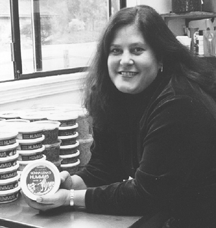

by Jessie Faulkner

Mary Keehn is not simply making a living making goat cheese in Dows Prairie. She's dazzling the snobbiest connoisseurs across the United States and around the world.
In August at the American Cheese Society's competition in Seattle, Keehn's PeeWee Pyramid took top honors in the soft-ripened goat cheese class, the Herb Chevre placed first in spice and herb goat cheese class, and the Humboldt Fog -- an aged, mold-ripened goat cheese with a distinctive gray vein of edible French vegetable ash -- finished atop the American Original category, the equivalent of an Academy Award in the cheese business.
In March Humboldt Fog scored 99.5 out of 100 points at a world cheese competition in Madison, Wis., placing third in a field of hundreds of entries from around the globe.
"It's a completely new cheese. No one has ever made it before," Keehn said with an obvious note of parental pride.
Since she began making cheese commercially 14 years ago, Keehn's company, Cypress Grove Chevre, has gathered 26 gold and best-of-show awards in national and international competitions. Sales have escalated at a rate of 25 to 40 percent per year.
Not bad for an enterprise operating out of an old barn on a former chicken ranch in McKinleyville.
But Cypress Grove Chevre is just one of a number of North Coast food and beverage producers that constitute a growing segment of the economy.
According to a report in the North Coast Almanac, by local economic analyst Phyllis Lammers, food and fish processing jobs have grown 58.5 percent from 1991 to September of 1997 -- from 540 to 856.
Some of the growth is coming from Humboldt County's traditional large food producers including Fluhrer's Big Loaf Bakeries and Humboldt Creamery's new ice cream plant (see separate story page 17). But increases in sales and jobs are also coming from medium- and small-volume mom-and-pop food producers as well.
Manufacturers of salsa, salad dressing and mustards number in the double digits. Humboldt Harvest, a marketing collective for local producers, counts 50 food manufacturers in its membership.
"There are many microenterprises that aren't employers but whose owners and family may work in food making," said Anita Alexander, a labor market specialist for the state Employment Development Department in Eureka.
"As their products became successful and they need more help, they become part of the employer community -- then we count them," she said.
Cypress Grove Chevre was strictly a family-run operation until 1986 when sales began to take off. Keehn now employs 14 and has at least 40 major distributors to get her products to market. That doesn't include the more than 100 stores Cypress Grove Chevre deals with directly. With this volume, Keehn relies heavily on her daughter, Malorie McCurdy, for help.
"She's the creator," McCurdy said, looking at her mother. "I'm the organizer and disciplinarian."
Keehn said business growth was pretty slow in 1984 when goat cheese hadn't reached its current status of gourmet goodness.
"In the early 1980s, you could hardly get people to taste goat cheese," she recalled.
Local taste buds still lag behind more urban areas. Keehn said she sells just 1 to 2 percent of her product locally, but in more urban areas sales are soaring.
Her cheese can be found in all the Whole Food markets nationwide, in the well-known East Coast Dean and Deluca gourmet delis, and in numerous five-star restaurants. Cypress Grove Chevre is served as part of New York City's Picholene's acclaimed cheese course, and at both Moose's Restaurant and Campton Place in San Francisco.
A chance sampling of the Cypress Grove Chevre cheese at Picholene's led to a feature article in Vogue magazine. And this summer four chefs used Cypress Grove Chevre at the prestigious James Beard Foundation competition in New York.
Until six years ago, Keehn not only processed the cheese but ran a goat herd to provide the key ingredient -- milk. Giving up the herd ultimately helped the business and her own survival.
"It seemed the obvious solution to working 40 hours a day," Mary said. Today she buys about half her milk from Humboldt County goat milkers.
The market beyond Humboldt is often vital to success of local producers. For some, that means earning a place in distributors' trucks, convincing Bay Area markets to give them a shot or finding profitable placement in mail-order catalogs.
Roger Lawson, general manager and founder of Humboldt Sausage Works in McKinleyville, began focusing on building up outside markets in 1995.
"Humboldt County is a great place to manufacture, but to get into the big leagues you have to get into the big cities," he said.
"That's where the speciality markets are that you don't see here. It's not that we don't love Humboldt County, but we don't have 11 million people."
Sales Manager Deak McCarthy's sole responsibility is to get his company's products -- ranging from chicken sausage to smoked honey ham -- into those larger markets.
The company sells roughly 900,000 pounds of meat a year and brings in about $2 million gross -- a growth due largely to a switch from retail to wholesale. That redefined focus meant the difference between simply getting by and taking off.
"We started as retailers here in 1990," Lawson said. "The wholesale did far more business, and retail was obviously the one to go."

Cindy Timek of Nonna Lena.
The Nonna Lena brand of pesto, hummus and garlic spreads got an early and successful start by reaching out-of-the-area markets.
"I started expanding, No. 1, my market, and No. 2, my product line," said owner and founder Cindy Timek. "We got a Bay Area distributor to pick us up within the first year. So it didn't take us long to have San Francisco connections."
Timek's wares got another early boost when they were picked up by the Safeways in Oregon and Washington.
"We had a broker in Oregon who presented our products to the head of the Oregon and Washington deli buyers and they picked up our products as direct buys, then turned them over to a distributor of their choice. We didn't seek out a distributor. They did the whole thing.
"Originally, what helped a lot of local producers, was a distributor here called Whole Food Express, owned by a subsidiary of the North Coast Co-op. They took all of our products and started distributing them throughout Northern California, Oregon, a little bit into Southern California, and they were doing really well.
"That company got bought up by a larger company. And those of us who were already pre-existing in that company got bought up right along with it. So then, our distribution expanded to 15 states."
Gourmets in the 15 states can rejoice. Timek's small tubs of flavors supplement the original pesto, a recipe of her husband's grandmother and the company's namesake, Nonna Lena Pedrazzoli, a native of Sondrio, Italy, in the Italian Alps.
Now, more than 11 years since the company's start, the product line has been expanded to include four different kinds of pesto, including a Sicilian pesto, which uses olive oil in response to health-oriented consumers.
Hummus was next in line, a ground-garbanzo-bean spread or dip that is dressed with an assortment of spices and special ingredients.
Timek's first hummus hit the shelves four years ago and she was not at all sure of the outcome.
"It's now our No. 1 selling product by volume -- the plain hummus, we sell hundreds of cases every week. It's been a great product for us."
The black-bean variety just hit the shelves in June. A mixture of garbanzos and black beans, the product takes on a southwestern flavor with cilantro, garlic and fresh jalapeños replacing the traditional parsley.
Since starting the business with the help of friend and fellow food producer Lindra Lomeli, mother of Casa Lindra salsa, Timek has introduced a new product every year.
She is also gearing up her business for a major shift in the types of products grocery stores are seeking.
"They're switching to serving whole foods," Timek said. "They want more manufacturers to move in the direction of preparing dishes that will be fresh, ready to go home and throw in your oven like Murphy's Take-and-Bake."
Eleven years after Timek switched from being a substitute high school art teacher to a full-time commercial food producer, the company is doing just under $250,000 a year in sales of 10 products including garlic butter, garlic spread, creamy pesto and zesty cilantro salad dressings.
A small commercial kitchen off the Timeks' garage is the center of activity for three part-time employees.
"It's just way too small," Timek said. "It often keeps us from hiring more people if we need to. We just have to work ourselves till we die."
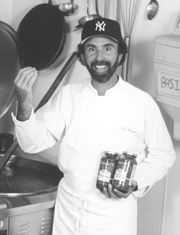
Tom Pagano of Tomaso's Specialty Foods
Tom Pagano, owner of Tomaso's Specialty Products, doesn't have that problem. He and Scott Bradshaw, owner of Fish Brothers, have begun construction on a building in Blue Lake's Industrial Park. The 5,000-square-foot building will be split down the middle to separate the two enterprises. Both businesses are running out of space at the Foodworks, a business incubator project located in Arcata's Industrial Park.
"The main reason we're moving out is not only to get some room to work in but also to build equity in our own building," Pagano said.
For Pagano, the ability to pay off the new building depends in part, on shipping his products -- no longer just pasta sauce -- to consumers in other areas. Among the offerings are four types of salad dressings, bean dip, clam and smoked pasta salmon sauces.
Like Timek, Pagano started out with his Italian grandmother's recipe for marinara sauce. Six other varieties of the pasta sauce have since been added, but the marinara remains Pagano's favorite.
"Basically, these are just my family recipes from the time I was growing up, or other sauces that I've tasted that are traditional Italian sauces like puttanesca, a tomato sauce that has fresh garlic, fresh basil, Mediterranean olives, tomatoes and olive oil."
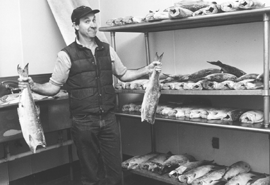 Scott Bradshaw of Fish Brothers
Scott Bradshaw of Fish Brothers
For Bradshaw, the yet-to-be-built Blue Lake plant is the latest in a series of locales where he's smoked and seasoned an assortment of fish.
The fish story began 14 years ago when Bradshaw and two friends decided to try the smoked fish business. One of the friends was a commercial fisherman, the other had marketing and merchandising experience.
"Shortly thereafter -- literally a matter of a few weeks or months -- they had their own jobs to go back to and I really didn't, so I continued on with it," he said.
Several years passed before he hired help. Now the small business employs four people and ships the delicacies all over the country.
In a year, Fish Brothers sells some 50,000-60,000 pounds of the smoked product -- ranging from albacore to salmon to trout. The goal for 1998 is $500,000 in annual sales -- in part because of a willingness to venture beyond traditional flavors, such as jalapeño smoked salmon.
"Jalapeño is a pretty hot item in the market, no pun intended," Bradshaw said.
The mix has been selling well as are all of the products made without chemicals and artificial colors.
"It's basically just fish, salt and spices," he said.
What sets each smokehouse apart is the brine -- the spicy marinade that soaks in the final flavor.
"There are probably as many different brines as there are smokehouses," Bradshaw said.
Fish Brothers' newest offering is smoked sturgeon. Bradshaw is quick to clarify that the fish are farm-raised. When first considering adding the product, Bradshaw said he thought it was too expensive.
"But when I got a sample and smoked it, it was so delicious that I said I don't care, people will pay for it."
On the market for roughly a year, Bradshaw's prediction proved to be correct.
"It's been going pretty well. It's super moist, has a great flavor and it's different enough that it's not just another smoked white fish," he said.
Bradshaw had a few words of advice for food producers just starting out.
"You've really got to go out there and sell your product. If you're not a salesperson, find someone who is," he said.
Bob Laffranchi of Loleta Cheese Co. agreed. In 1990, the then 8-year-old enterprise began concentrating efforts to get the cheese on the shelves of stores in other areas. Production volumes jumped from 800,000 to 4 million pounds of cheese a year in just four years.
"Once established, you have to expand out of Humboldt County," Laffranchi said. "That's one of the reasons in 1990, we began marketing out of the county. Until that time, Humboldt and Del Norte counties were our marketing areas. The support of folks in Humboldt is what gave us the opportunity to expand."
These days the popular cheese comes in six basic varieties and 17 different flavors. Among the most popular is the jalapeño jack. In the last six months, Loleta Cheese has introduced Havarte with herbs and spices -- sweet bell peppers, onions, dill and a couple of secret ingredients.
Another addition is a fresh cheese, the traditional Mexican queso fresco. Ninety-nine percent of the perishable cheese is shipped to the Bay Area, but small amounts are available through the plant's factory store. Laffranchi said the firm began producing the cheese after a distributor in Los Angeles was looking for a new supplier. After two years of testing, the product was on the shelves and is doing well.
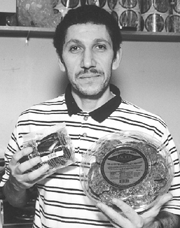
Emran Essa of Desserts on Us
Emran Essa's Desserts on Us -- producers of a delectable half-cookie, half-confection known as Laceys and carefully crafted Baklava -- got a big boost early in the game.
Shortly after beginning production in December 1990, the baker's products were included in the "California Cuisine" mail-order catalog. Two years later, the catalog business was bought by Hickory Farms, known for its seasonal stores and year-round catalog sales of gourmet goods.
The Desserts on Us line has since been expanded to include Baklabars, a chocolate-dipped baklava, three different varieties of the Laceys and an assortment of packaging sizes. This has improved the company's profit margin and won awards for package design.
Eighty percent of the baklava is marketed outside the county. In 1993, Gourmet Retailer magazine gave the product its "Best of the Aisle" award and national exposure.
The business actually began with the baklava when Essa wasn't able to find a sample of the layered, honey and almonds sweet dessert to his liking.
Back home in Syria, he said, the pastry was made with walnuts, but the Western preference is for almonds. His compromise was to combine the two -- something other baklava producers have subsequently copied.
Meanwhile, the business maintains two kitchens at the Arcata Foodworks, one for baklava and one for the Laceys. Bay Area markets include restaurants, supermarket chains and coffee houses.
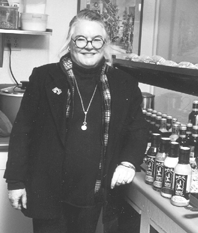
Carol Davis of Pacific Rim Noodle House
Carol Davis isn't inclined to call her venture into the food manufacturing business a success quite yet. After several years of building a loyal customer pool at Pacific Rim Noodle House in Arcata, the co-owner -- who shares that designation with her daughter, Catlin Conlin -- decided to bottle the popular sauces.
The four varieties are now in such well-known stores as Neiman-Marcus in San Francisco and Marshall Fields in Chicago. The specialty sauces are sold as far away as Boca Raton, Fla., and can be found up and down the Eastern seaboard.
After attempting to bottle the sauces herself and unable to find a local outlet for getting it done, Davis contracted a firm in Auburn, near Sacramento, which helps with distribution of the sauces.
Davis said contracting the actual production of the sauce has left her free to develop an obsession with the marketing end of the business.
A lifetime love affair with cooking and careful research spawned the noodle house. The marketing of the sauces was an added plus.
"It's like being in school again," she said. "I learn something everyday."
She's allowing five years for the sauce sales to become established. In the meantime she is also selling sushi and wraps -- an Asian version of the burrito -- in local stores and to Mad River Community Hospital.
Of the four sauces -- Island Ginger Orange, Sweet 'n' Sassy Soy Vinaigrette, Tasty Thai Peanut Sauce and Creamy Wasabi -- the latter is Davis' favorite.
The jury's still out on the sauces' financial showing, but the noodle house averages $100,000 a year in sales, she said.
If, as economic analyst Phyllis Lammers says, the immediate past is a good indicator of the future, the full story of local food manufacturers hasn't been told.
Between 1992 and 1995, the number of jobs in food manufacturing was the second fastest growing sector in Humboldt County -- following close behind the EDD-titled amusement/recreation (meaning casinos, theaters, arcades). Food manufacturing, not dependent on North Coast markets, has the potential to lead the pack.
BREWUS ROBUSTUS --Humboldt County's five microbreweries
BIG KIDS ON THE BLOCK -- Humboldt Creamery & Fluhrer Bakeries